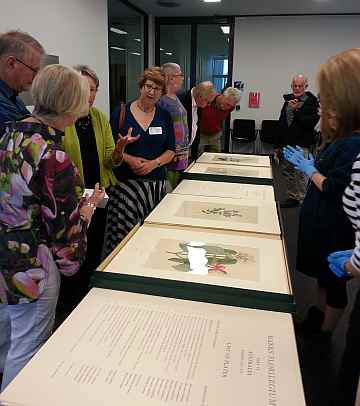Banks' Florilegium at the National Library of Australia
You are here

Banks' Florilegium
Viewing of selected works from the Australian component of Banks' Florilegium
Notes prepared by Catriona Anderson
Banks' Florilegium has its origin in the 1768-1771 Endeavour voyage of discovery and circumnavigation of the globe lead by Captain James Cook.
On the Endeavour journey, botanist Joseph Banks led a team comprising: Daniel Solander (distinguished Swedish naturalist and pupil of Carl Linnaeus); the natural history and landscape artists Sydney Parkinson and Alexander Buchan; and a team of field assistants.
The prints in Banks' Florilegium are based on the field drawings made by the artist Sydney Parkinson and the accompanying botanical specimens collected. The estimation is Parkinson generated 955 drawings on the voyage (675 sketches, 280 finished drawings).
Banks did not publish the Florilegium during his lifetime, although he had intended to.
In 1773 he employed five water colourists to complete the 595 artworks based on Parkinson's unfinished work. He also employed 18 engravers, over the course of 13 years until 1786, to cut the copper printing plates, based on a total of 743 artworks, in readiness for scientific publication in colour. Only proof prints of some works were made in Banks' lifetime. The engraved copperplates are held in the British Museum.
Between 1900 and 1905, the British Museum (Natural History) issued lithographic prints of 315 of the engravings, under the title "Illustrations of Australian Plants".
In 1973, a selection of 30 prints from the copperplate engravings were published in a bound volume entitled "Captain Cook's Florilegium", however these were not colour prints.
Banks' Florilegium
This collection of colour prints - known as Banks' Florilegium - is the first complete full colour edition of the Florilegium. It was published between 1980 and 1990 in 34 parts by the private company Alecto Historical Editions in conjunction with the British Museum (Natural History).
The plates were printed using a 17th century technique known as "a la poupee" - a multi-coloured single plate printing process using cloth to apply the ink to the etchings in the plate. Some of the prints used up to 15 different colours. A production team of 20 staff worked initially in a studio in the East End of London, led by master printer Edward Edgerton-Williams. Colour accuracy was checked against Parkinson's notes and a colour chart produced by the Royal Horticultural Society, in consultation with provenance authentication by the British Museum's botanical editor Chris Humphries and Botany Librarian Judith Diment, a process that involved assessment using the original specimen gathered by Banks and Solander, the notes and diaries kept, and Parkinson's original sketches and watercolours.
The collection of botanical illustrations consists of 745 prints. 100 sets were made available for sale, many of those on a subscription basis. Some additional sets were made for exhibition and display purposes.
Of the 34 parts:
Parts 1 - 15 consist of 337 plates of Australian flora.
Parts 16 - 34 consist of plates of plants from Brazil, Madeira, NZ, Java, Society Islands and Tierra del Fuego.
The plants recorded here in Australia were during the ten days spent in Botany Bay (28 April – 6 May 1770) and from along the coast of Queensland from May to August 1770.
Text accompanying the illustrations
The text printed with the illustrations, in italics on each mount, is the name given by Banks and Solander as recorded in their manuscripts and in Solander’s manuscript slip catalogue held by the Botany Library of the British Museum (Natural History).
The information on the mounts is in the order: name of artist(s), date of the original watercolour drawing(s); plate number; engravers’ names; modern name; manuscript name; place and date of discovery of the actual specimen illustrated.
Suggested reading
"Sydney Parkinson: artist of Cook's Endeavour voyage" - 1983 ANU Press publication in association with the British Museum (Natural History), edited by Denis Carr.
The Florilegium : Cook - Banks - Parkinson, 1768-1771, catalogue compiled by Hank Ebes, Sotheby's 1988.
"Flowering of the Pacific : Banks' Florilegium" - 1984 ABC documentary, produced and directed by Brian Adams, presented by Robert Hughes.
(Note: The text of Catriona's talk at the Friends' Twilight Dinner will be added soon)

